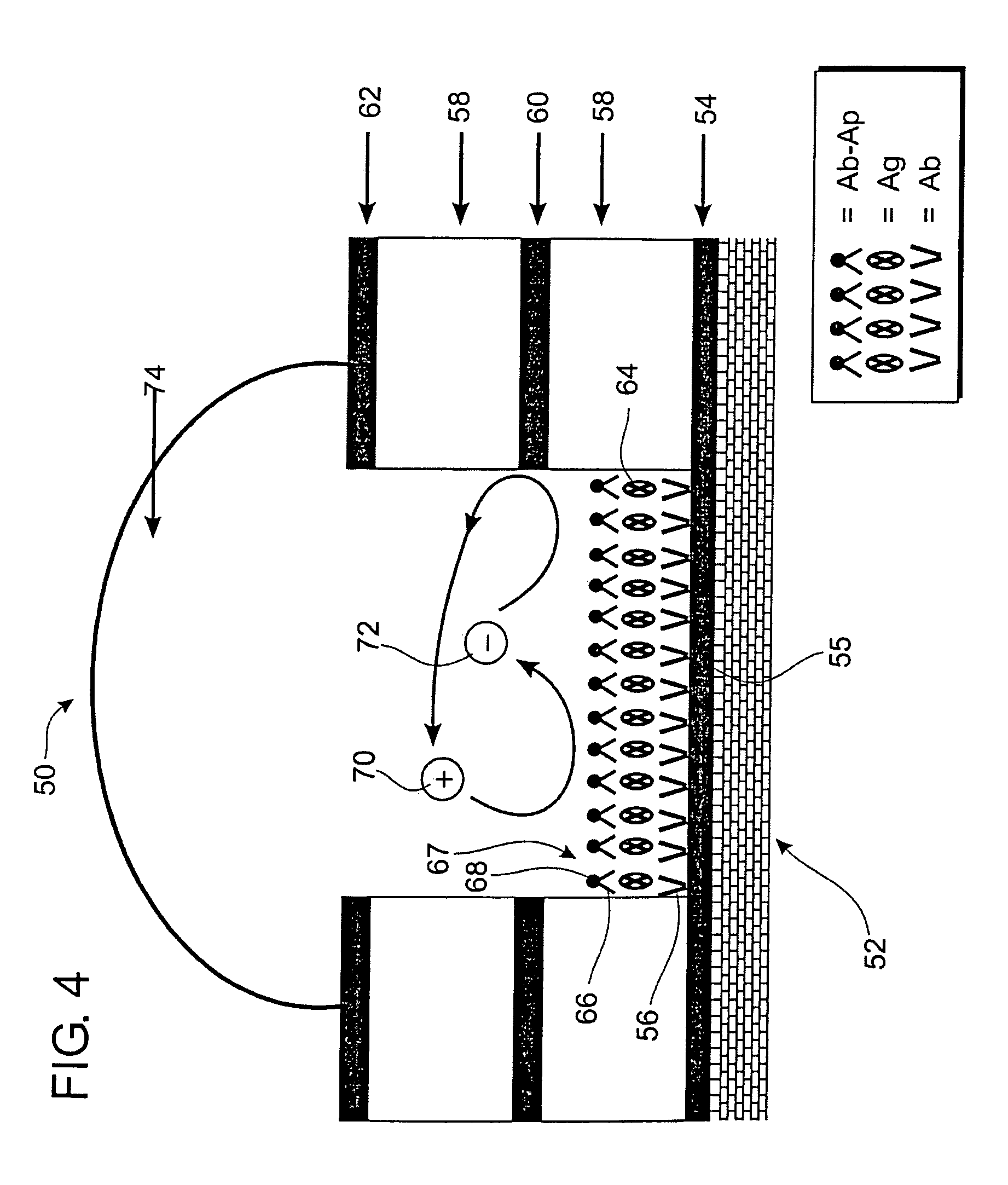Self-contained microelectrochemical bioassay platforms and methods
a microelectrochemical and bioassay technology, applied in the direction of fluid speed measurement, positive displacement liquid engine, chemical vapor deposition coating, etc., can solve the problems of not including a separation step, unfavorable immunoactive physisorption, and unfavorable immunoactive physisorption, so as to improve detection limits, sensitivity and speed, and improve detection accuracy. , the effect of improving the detection limi
- Summary
- Abstract
- Description
- Claims
- Application Information
AI Technical Summary
Benefits of technology
Problems solved by technology
Method used
Image
Examples
example 1
[0101]Fabrication of macrochips. Au macrochips (approximately 1.4 cm×2 cm, where the electroactive area is about 0.6 to 1 cm2) were made from a 125 mm diameter silicon wafer substrate that had 1.4 to 1.8 m SiO2 deposited on both sides at 250° C. by plasma enhanced chemical vapor deposition (PEVCD, Plasma Therm System VII). Deposition of a 15 μM adhesion layer of Cr and 1000 μm of Au was carried out using an Edwards Auto 306 TURBO thermal evaporator (Edwards High Vacuum Instrument International, West Sussex, UK). The Au macrochips were diced to size by hand using a diamond scribe. Polyimide (PI) macrochips were made using the Au macrochips as the starting substrate and spin coating a 4 μm thick layer of polyimide followed by cross-linking with UV light at 350 nm for 12 s and curing at 150° C. for 30 min and at 250° C. for another 30 min. The Au coated silicon wafer was spin-rinsed-dried (SRD) using ST 270D (Semitool, Calif.) for a total of 400 s before spin coating the PI. This proce...
example 2
[0143]The following novel technique was designed because there is no existing electrochemical immunoassay for Cryptosporidium parvum-ZPA. Although the method described below is macroscale, those skilled in the art will recognize that it may easily be scaled down to operate within a microstructure as shown in FIG. 10 and may be adapted for detection of a variety of microorganisms simply by changing the antibodies used.
[0144]1) Deposit 50 Å(angstrom) chromium (Cr) followed by 1000 Å gold (Au) on 5 on oxidized silicon wafers using thermal vapor deposition.
[0145]2) Using a diamond scribe cut the wafer into 1.2×1.2 cm2 Au chips.
[0146]3) Clean with piranha (3 parts 30% H2O2 hydrogen peroxide: 7 parts concentrated H2SO4 sulfuric acid) and rinse thoroughly with running dI water.
[0147]4) Deposit self assembled monolayers (SAMs) using 25 mL of 4 mM MUA (mercaptoundecanoic acid) or MUOL (mercaptoundecanol) in ethanol overnight inside an Ar (argon) purged glove bag.
[0148]5) Rinse thoroughly wit...
example 3
[0156]The novel DNA-hybridization Assay for Cryptosporidium parvum-Macro system described below was developed to demonstrate the feasibility of the viability assay for microorganisms. Those skilled in the art will appreciate that this method is easily scaled down to work inside a microstructure, as shown in FIG. 11B.
[0157]Make sure all solutions and solvents are filtered with 0.2 μm filter. Vortex all solutions before to use. Autoclave deionized (dI) water for all solutions. Use only RNAse and DNAase free reagents without autoclaving.
[0158]Macro Chips
[0159]1) Deposit ˜100 Å Cr / 1000 Å Au on 5 in silicon wafer (Si / SiO2) using BOC Edwards Thermal Evaporator.
[0160]2) Dice with a diamond tip scrib to 1.2×1.2 cm2 pieces or macro chips.
[0161]3) Soak macro chips in piranha solution for 30 min then wash thoroughly with running dl water.
[0162]MUOL SAMs
[0163]1) Inside an AR filled glovebag, soak the chips in 4 mM MUOL in ethanol overnight.
[0164]2) Rinse three times with ethanol followed by dI ...
PUM
| Property | Measurement | Unit |
|---|---|---|
| volume | aaaaa | aaaaa |
| pH | aaaaa | aaaaa |
| volumes | aaaaa | aaaaa |
Abstract
Description
Claims
Application Information
 Login to View More
Login to View More - R&D
- Intellectual Property
- Life Sciences
- Materials
- Tech Scout
- Unparalleled Data Quality
- Higher Quality Content
- 60% Fewer Hallucinations
Browse by: Latest US Patents, China's latest patents, Technical Efficacy Thesaurus, Application Domain, Technology Topic, Popular Technical Reports.
© 2025 PatSnap. All rights reserved.Legal|Privacy policy|Modern Slavery Act Transparency Statement|Sitemap|About US| Contact US: help@patsnap.com



